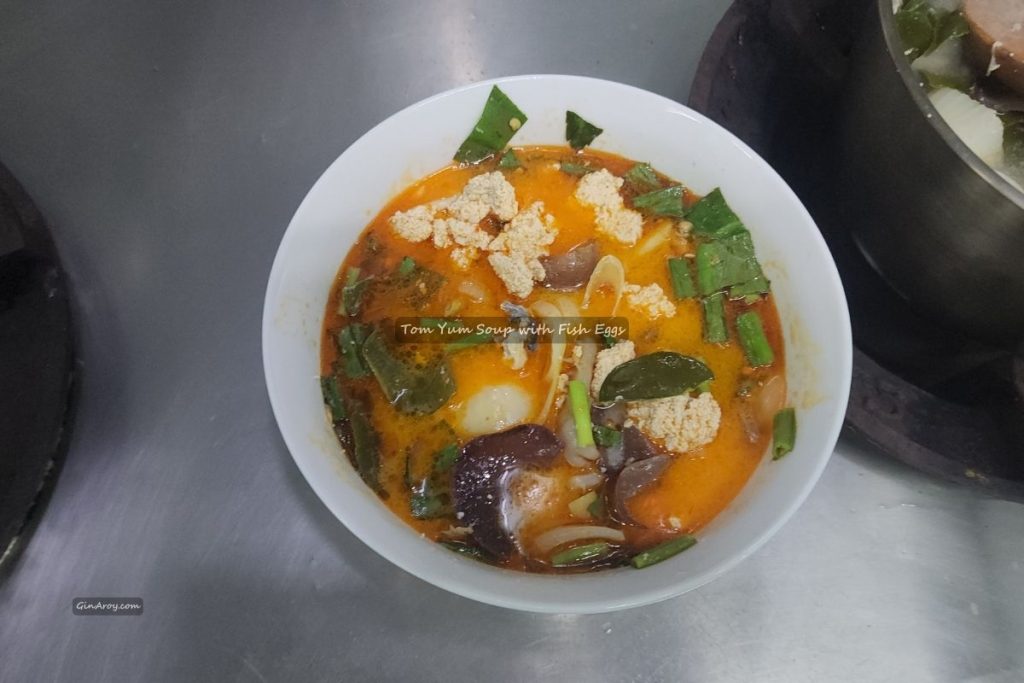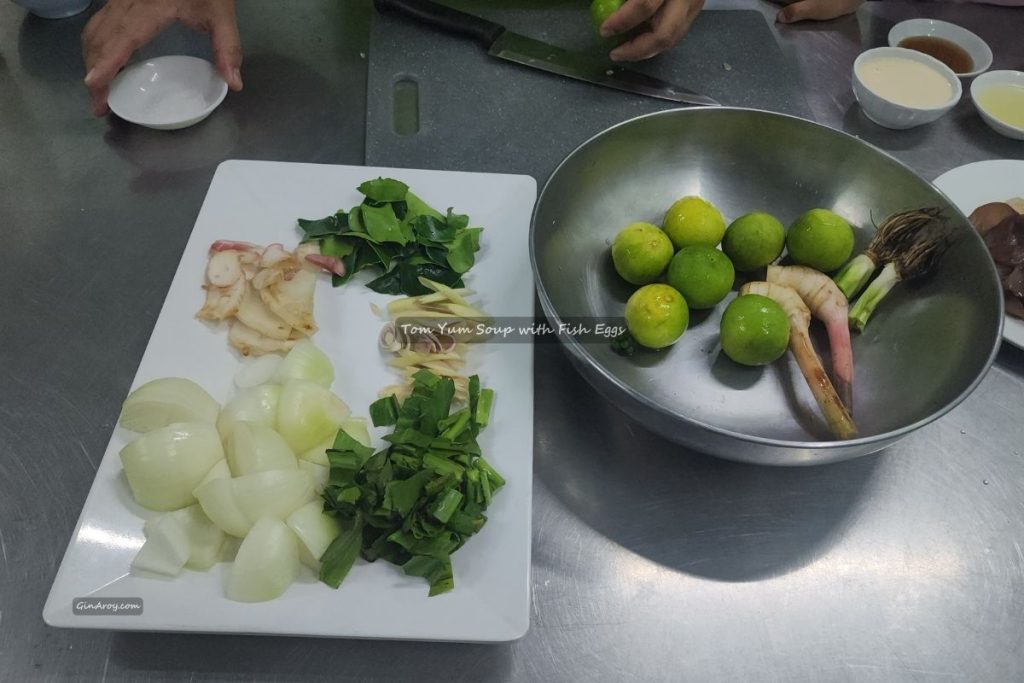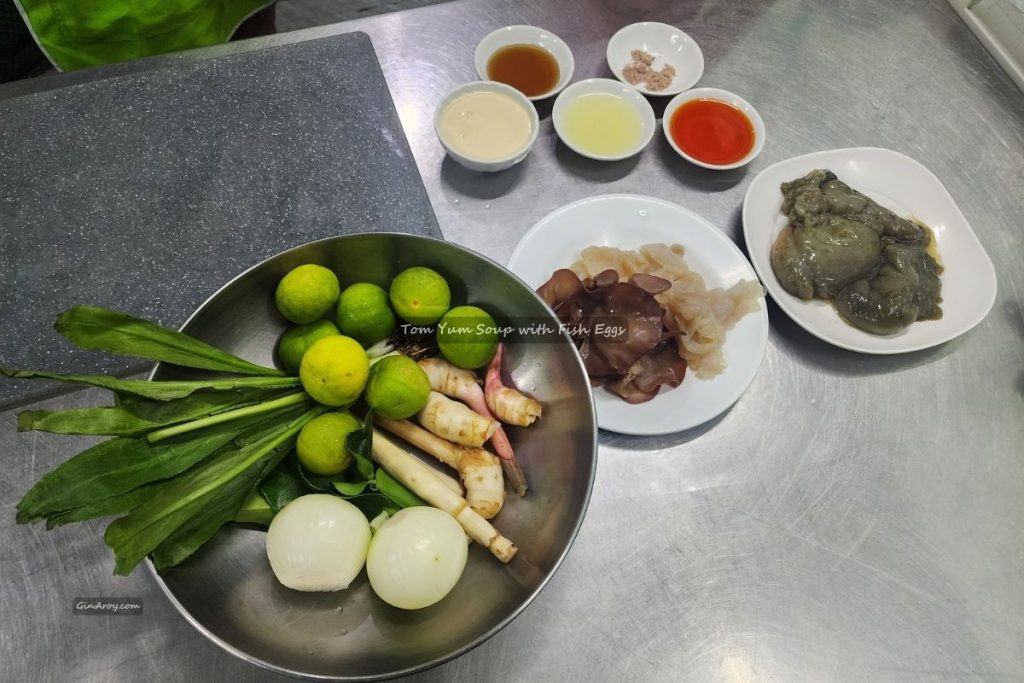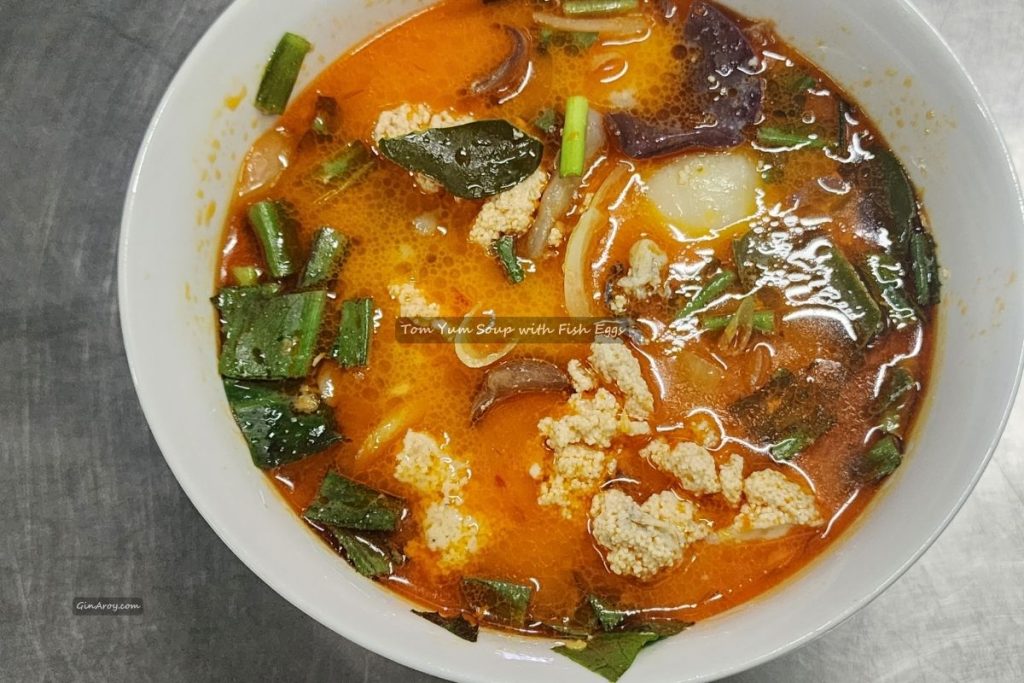- 🥣 Introduction: The Heart of Thai Comfort Food
- 🌿 Ingredients That Tell a Story
- 🔥 Step-by-Step Cooking Guide
- 🐟 The Story Behind Fish Eggs in Thai Cuisine
- 🧠 Cultural Notes: Tom Yum Across Thailand
- 💡 Pro Cooking Tips from GinAroy
- 🌶️ Flavor Profile Breakdown
- 🥢 How to Serve & Pair
- 🥦 Nutrition Facts & Health Benefits of Tom Yum Soup with Fish Eggs
- 🧘♀️ Health Benefits of Tom Yum Soup with Fish Eggs
- 🌏 Final Thoughts
- ❓ FAQs – Tom Yum Soup with Fish Eggs
🥣 Introduction: The Heart of Thai Comfort Food
Few dishes represent Thailand’s culinary identity as perfectly as Tom Yum Soup. It’s more than just a bowl of spicy-sour broth — it’s a reflection of Thailand’s love for balance, color, and freshness.
Traditionally made with shrimp or mixed seafood, Tom Yum Soup with Fish Eggs offers a surprising yet delicious twist that’s both luxurious and comforting. The creamy yet tangy base, enriched with chili oil, lime juice, and condensed milk, blends harmoniously with the delicate texture of fish eggs.

In Thailand, locals love experimenting with ingredients, especially in regional dishes. While central Thai kitchens favor shrimp or fish, northern and northeastern regions sometimes include fish eggs — a prized delicacy that adds a unique pop and umami to the soup.
This version combines catfish eggs, jellyfish, and wood ear mushrooms — creating a satisfying, protein-rich dish that’s both nutritious and memorable.
🌿 Ingredients That Tell a Story
Every Thai recipe begins with a tale of balance — sour, salty, spicy, and a hint of sweetness. This dish is no exception.

Main Components:
- Catfish Eggs: Soft, creamy, and slightly briny, these add richness and depth to the soup.
- Jellyfish: Offers a chewy texture that contrasts beautifully with the tender fish eggs.
- Wood Ear Mushrooms: Add an earthy note and absorb the spicy-sour broth perfectly.
Herbs & Aromatics:
- Lemongrass: The backbone of Thai soups — citrusy and refreshing.
- Galangal: A cousin of ginger with a sharp, floral aroma that defines Tom Yum.
- Kaffir Lime Leaves: Adds brightness and complexity with each fragrant tear.
- Sawtooth Coriander: A vibrant herb often used in Thai and Lao cooking for a punch of green freshness.
- Onion: Adds sweetness and helps balance the heat.
The Creamy Sauce Blend:
- Lime Juice: For acidity and zest.
- Fish Sauce: The salty soul of Thai cooking.
- Chili Oil: Brings heat and color.
- Condensed Milk: Adds body and a subtle sweetness — a modern Thai touch.
- Sugar: Balances the tang and spice.
👉 “Love the taste of the ocean? Explore Thailand’s coastal flavors in our deep dive on Thai Seafood Dishes From Coast To Plate.”
🔥 Step-by-Step Cooking Guide
1. Build the Flavor Base
Start by heating 4 cups of water or light fish stock in a pot.
Add lemongrass, galangal, kaffir lime leaves, and onion.
Let them simmer gently for 5–7 minutes until the kitchen fills with an irresistible herbal aroma.

This step is essential — Thai cuisine values patience in drawing out aromatics, and the slow simmer ensures a deep, layered flavor before any protein touches the pot.
2. Add the Seafood
Once the broth is aromatic, add the catfish eggs, jellyfish, and wood ear mushrooms.
Let them cook slowly on medium heat. Avoid stirring too hard — fish eggs are delicate, and you want them to remain whole and creamy.
The jellyfish provides chewiness, while the mushrooms soak up the flavor, creating a symphony of textures.
3. Balance the Flavors
Lower the heat and stir in:
- 3 tbsp lime juice
- 2 tbsp fish sauce
- 1 tbsp chili oil
- 1 tbsp condensed milk
- 1 tsp sugar
Taste the broth — the perfect Tom Yum should hit all your senses at once: spicy first, then sour, salty, and slightly creamy. Adjust as needed to match your personal taste.
4. Finish with Fresh Herbs
Just before serving, add chopped sawtooth coriander and a squeeze of lime.
This final touch gives your soup a burst of freshness and color.
5. Serve Hot
Serve immediately while it’s steaming hot. Tom Yum is best enjoyed fresh, with steamed jasmine rice or on its own as a flavorful soup.
👉 Watch the full cooking video here: 🎥 Click to Watch on YouTube @GinAroy66
🐟 The Story Behind Fish Eggs in Thai Cuisine
Fish eggs, or “ไข่ปลา” (Khai Pla), have long been a delicacy in Thailand.
In Thai culture, they are prized for their texture — soft yet firm, rich in omega-3 fatty acids, and believed to bring good health and strength.

In rural Thai markets, you can often find fresh fish eggs sold alongside other seafood for curries, soups, or grilled dishes. They symbolize abundance and nourishment — something families often prepare during festive occasions or family gatherings.
Adding them to Tom Yum transforms a classic street-food soup into something special — a gourmet Thai dish with rustic roots.
🧠 Cultural Notes: Tom Yum Across Thailand
While the version most tourists know is Tom Yum Goong (shrimp soup), there are countless regional variations:
- Central Thailand: Often creamy (Tom Yum Nam Khon) with coconut milk or evaporated milk.
- Isaan (Northeast Thailand): Simpler, clear-broth style (Tom Yum Nam Sai) — light, herbal, and tangy.
- Southern Thailand: Spicier and richer, often with seafood like crab, squid, or fish roe.
This Fish Egg Tom Yum sits somewhere between — it borrows the creamy texture from central Thai cooking but adds coastal seafood ingredients for a southern-style punch.
💡 Pro Cooking Tips from GinAroy
- Don’t Boil Too Hard: Fish eggs can burst if boiled aggressively. Keep the heat medium-low.
- Fresh Herbs Matter: Always tear, not cut, the kaffir lime leaves — it releases essential oils better.
- Jellyfish Prep: Soak salted jellyfish in cold water for 15–20 minutes before cooking to reduce saltiness.
- Balance the Heat: Adjust chili oil to your spice level — Thai spicy is not for the faint-hearted!
- Add a Dash of Coconut Milk: For a richer mouthfeel, replace half the condensed milk with coconut milk.
🌶️ Flavor Profile Breakdown
| Taste Element | Ingredient Source | Flavor Note |
|---|---|---|
| Spicy | Chili oil | Warming heat that enhances aroma |
| Sour | Lime juice | Bright and zesty |
| Salty | Fish sauce | Savory umami depth |
| Sweet | Condensed milk & sugar | Softens acidity |
| Creamy | Condensed milk | Balances spice for a smooth finish |
The result? A bowl that dances between fiery, tangy, creamy, and aromatic — an unforgettable Thai taste experience.
🥢 How to Serve & Pair
- Serve hot with steamed jasmine rice or sticky rice.
- For a full Thai meal, pair it with:
- Fried mackerel and nam prik (Thai chili dip)
- Thai omelet with herbs
- Fresh cucumber slices or long beans on the side

Drink pairing: Try iced Thai tea or lemongrass water — the mild sweetness complements the soup’s spice perfectly.
👉 “Craving something rich and comforting? Don’t miss our step-by-step guide to Kha Moo Thai Slow-Braised Pork Leg.”
🥦 Nutrition Facts & Health Benefits of Tom Yum Soup with Fish Eggs
Beyond its irresistible aroma and spicy-sour flavor, Tom Yum Soup with Fish Eggs is surprisingly nutrient-rich and good for your body. Traditional Thai soups are known not just for taste, but for promoting balance and well-being — and this version is no exception.
💪 Nutritional Highlights (per serving, approx. 250–300 ml bowl)
| Nutrient | Estimated Amount | Health Benefit |
|---|---|---|
| Calories | 180–220 kcal | Light yet filling; great for lunch or dinner |
| Protein | 20–25 g | High-quality protein from fish eggs & seafood |
| Fat | 6–8 g | Mostly healthy unsaturated fats |
| Carbohydrates | 8–10 g | Minimal — from onions and milk |
| Omega-3 Fatty Acids | High | Supports heart, brain, and skin health |
| Vitamin C | High | From lime juice and fresh herbs |
| Iron & Zinc | Moderate | Supports blood health and immune function |
| Sodium | Moderate | From fish sauce (can be adjusted to taste) |
(Values are approximate and vary depending on portion size and ingredient ratios.)
🧘♀️ Health Benefits of Tom Yum Soup with Fish Eggs
This soup is not only delicious — it’s nourishing.
- Catfish eggs: High in protein and omega-3s.
- Lemongrass & kaffir lime leaves: Aid digestion and reduce bloating.
- Galangal: Known for anti-inflammatory properties.
- Chili oil: Boosts metabolism and enhances circulation.
No wonder Thai people often refer to Tom Yum as both a meal and a natural tonic!
🌿 Key Health Benefits of Tom Yum Soup with Fish Eggs
1. Heart & Brain Support
Fish eggs are rich in Omega-3 fatty acids (EPA & DHA), which help lower cholesterol, improve circulation, and support brain function. They also contain high-quality protein, ideal for muscle repair and growth.
2. Immune-Boosting Properties
Herbs like galangal, lemongrass, and kaffir lime leaves are packed with antioxidants and natural oils that have antibacterial and antiviral properties — helping your immune system stay strong.
3. Anti-Inflammatory & Digestive Aid
Galangal and lemongrass are powerful anti-inflammatory agents. They also support digestion, relieve bloating, and help detoxify the body — a big reason Thai people often enjoy Tom Yum after heavy meals.
4. Weight-Friendly Comfort Food
Despite its rich flavor, Tom Yum Soup is naturally low in fat and calories. The chili oil stimulates metabolism, while the sour lime helps balance cravings — making it a healthy comfort food choice.
5. Mood & Energy Boost
Spicy soups like Tom Yum trigger endorphin release — those “happy hormones” that boost your mood and energy levels. Combined with aromatic herbs, it creates an uplifting sensory experience that’s as good for your mind as it is for your body.
🧘♀️ In Thai Culture
In Thailand, Tom Yum isn’t just food — it’s medicine in a bowl. Locals believe the combination of heat, herbs, and acidity helps balance the body’s energy (“Yin-Yang” principle in Thai herbal tradition).
Many Thais enjoy it when they feel tired, cold, or under the weather — a warm bowl of Tom Yum is both nourishing and healing.
🌏 Final Thoughts
Tom Yum Soup with Fish Eggs is a celebration of Thai creativity — transforming a humble soup into a dish full of texture, culture, and heart.
From the aromatic herbs that perfume your kitchen to the rich broth that warms your soul, this soup embodies what Thai food truly stands for:
👉 balance, freshness, and bold flavor.
Next time you crave something adventurous yet deeply Thai, skip the shrimp — and give Tom Yum Fish Eggs a try. You’ll taste the authentic soul of Thailand in every spoonful.
❓ FAQs – Tom Yum Soup with Fish Eggs
1. Can I substitute fish eggs with something else?
Yes! You can use shrimp, squid, or even tofu for a vegetarian version. The soup’s flavor comes mainly from the herbs and sauce.
2. Is condensed milk traditional in Tom Yum?
Originally, no. But modern Thai cooks often use condensed milk or evaporated milk to create a creamy Tom Yum Nam Khon. It softens the spice and adds body.
3. What’s the difference between Tom Yum and Tom Kha?
Tom Yum is spicy and sour, while Tom Kha Gai includes coconut milk and is milder and sweeter.
4. Can I store leftover Tom Yum?
Yes — keep it refrigerated for up to 2 days. However, the fresh herbs lose aroma over time, so reheat gently and add new lime juice before serving.
5. How spicy is Tom Yum Soup with Fish Eggs?
It depends on your chili oil quantity. Start mild and increase to taste — Thai heat builds fast!










